The advanced stats show that Notre Dame dominated Northwestern in most key phases of the game, yet special teams miscues, turnovers, and penalties let the Wildcats get within a score late in the 4th quarter. The Irish should walk away confident about a strong effort against a solid opponent, but maybe a bit concerned about these recurring hiccups resulting in close games.
Confused? Check out the advanced stats glossary here or holler at me in the comments.
The Basics

S&P+ gave Notre Dame a post-game win probability of 96.5%, which at first glance might feel high for a game where the Irish led by just three points with under three minutes to go. This high degree of confidence was based off a massive advantage in total yardage and yards per play for the Irish, with smaller but still significant edges in efficiency and the scoring chances generated. The Wildcats were able to make things close through the combination of a strong field position edge (taking advantage of gifts from the ND special teams unit), penalties, and some opportunistic drives that weren’t spectacular but converted just enough successful plays on key downs to score.
The close contest did not feature garbage time, though as usual end of half kneel-downs are excluded. In case you were wondering, penalties do not typically factor into any of these numbers, so in a game like this where penalties (in both number and yardage) are particularly one-sided that will be a blind spot for S&P+ and virtually all advanced stats systems.
Efficiency
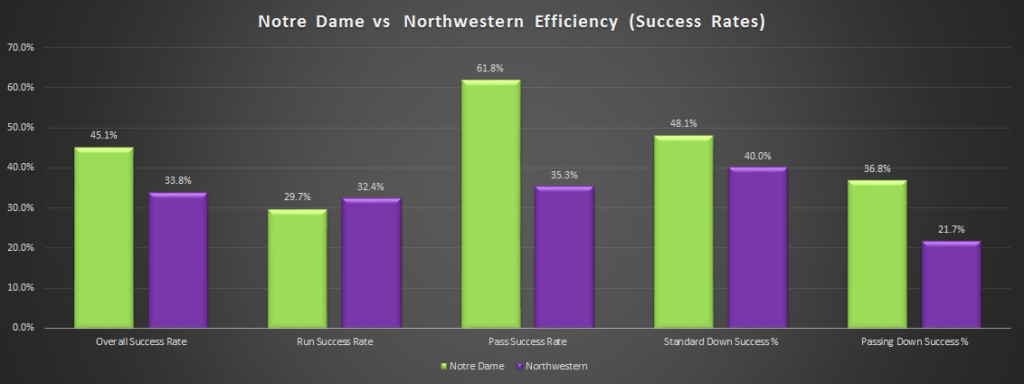
The Irish held a strong edge in efficiency thanks to the passing offense and Clark Lea’s defense doing its job making a bad Northwestern offense look bad. The latter wasn’t surprising, but the bigger shock and potential red flag was the disparity between Notre Dame’s run and pass success rates. Ian Book’s passes were twice as efficient as rush attempts (including scrambles, but that is a drop in the bucket in a gap of this magnitude). The run game sputtered after a strong performance against Navy, with below-average efficiency and just 3.6 yards per rush attempt compared to 10.1 yards per pass.
While the split in Evanston was extreme, this is emblematic of the larger trend for the Notre Dame offense, especially in the Book chapter. Book has been so accurate and efficient that it’s hard for the run game to compare, especially with the loss of Alex Bars and constant shuffling on the offensive line. Here’s a breakdown, excluding garbage time, of the run/pass splits and successes since Book took over:

The pass game has been more efficient and more explosive, whether measured by chunk plays of 20+ yards or yards per successful play (YPSP). Still, the run-pass ratio is essentially 50/50. That’s without a doubt not representative of the play-calling, since it includes scrambles as run plays and doesn’t account for RPO’s that give Ian Book both options. But the data make a compelling argument to dial up the pass attempts at least a bit more, especially with the offensive line solid in pass blocking (42nd in adjusted sack rate) but inconsistent when running (111th in run stuffs allowed).
Without looking too far ahead, that difference may be of heightened importance against better defenses. Just by removing the two worst defenses, Wake Forest and Navy, from the data-set, the gap between efficiency and YPP increases (success rate from +11.5% in favor of the pass to +19.2%, YPP from +2.46 to +2.75). Against a playoff-caliber defensive line I’m extremely skeptical about Notre Dame’s ability to run the ball consistently, and hopeful that the coaching staff would be self-aware enough to recognize that and move more heavily to the pass game that’s been so effective with Book at the helm.

Staying focused on the Wildcats and next few games, the defense remains extremely steady. While the Northwestern offense was a little more efficient than ideal, particularly running the ball, the Irish offense continues to force inferior opponents to sustain long drives, and they’ve largely failed. Through nine games the Notre Dame defense sits at 3rd in Defensive S&P+, fueled by just being really good at pretty much everything.
Check out these rankings in key categories, noting the consistency:
- 7th in opponent marginal explosiveness
- 12th in marginal efficiency allowed
- 8th in opponent points per red zone trip
- 15th in Rushing S&P+ Defense
- 14th in Passing S&P+ Defense
- 11th on Standard Downs S&P+
- 19th in Passing Downs S&P+
When the worst ranking in these major categories is still a top-20 performance, things are going pretty great. Importantly, the arrow should continue to trend upward with Drue Tranquill getting healthier, a potential late return of MTA, and hopefully an answer emerging to the 3rd cornerback question that’s been an enigma this season.
Explosiveness
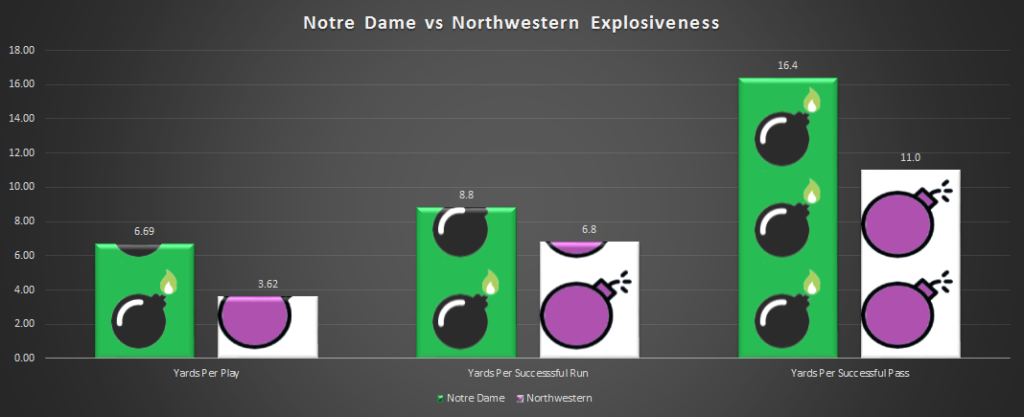
The Irish finished with a YPP advantage of +3.07, a dominant figure. I tweeted during the game when things got close that teams with a +2 to +3 margin in YPP won 95% of games with an average scoring margin of +24 points, but Notre Dame was trying to make it far closer. The final margin is definitely in the lower area of this range, but finishing in the +3 to +4 range inches that up to a 98.9% range with an average scoring margin of +32 points.
What should we take away from this? Essentially, the Irish played far better than the final score suggested in a critical road game in November. The good news is that Notre Dame didn’t play down to Northwestern’s caliber in the most important phases of the game. The bad news is that Brian Kelly’s team, not for the first time this season, allowed a final score far closer thanks to some special teams blunders and turnovers. Throw in the Pat Fitzgerald Eagle Scouts not being penalized at all in this game (besides a hold that the Irish declined) and you have a win that’s unimpressive in the eyes of the media and likely the playoff committee despite playing pretty well.
Chase Claypool received the game ball, putting up an impressive performance in a game where Miles Boykin was a bit limited by Wildcat corner Montre Hartage. Boykin was targeted 11 times but hauled in just four catches, averaging 4.91 yards per target. Meanwhile Claypool secured eight catches on ten targets, with an average of 12.9 yards per target.
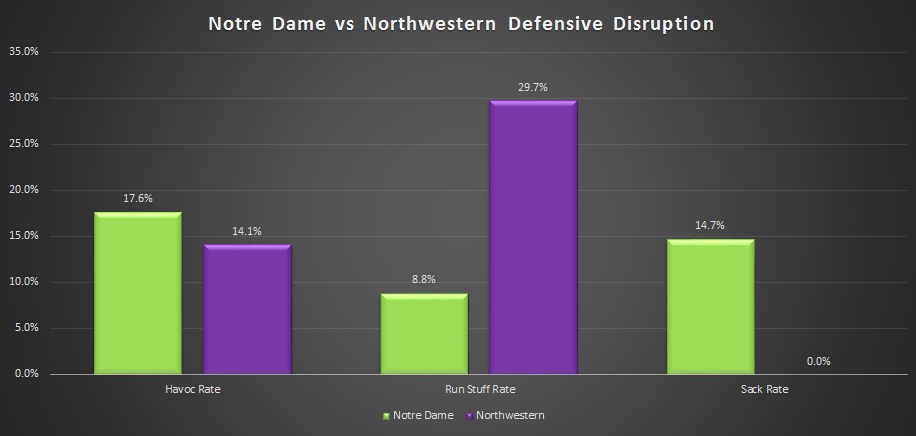
The Irish won the havoc battle, but I’ll confess to being a bit disappointed that it wasn’t a little better. The Cats had struggled mightily running the ball and Clayton Thorson had been generous with turnovers throughout 2018. The first half was particularly frustrating, as the Northwestern offense duct taped together a long touchdown drive on miraculous plays, penalties, and the bare minimum efficiency needed to sustain drives. In the second half the dam finally broke – the near-misses actualizing into sacks of Thorson, and a few more pass deflections.
The nearly 30% run stuff rate for Northwestern was ugly, especially with a few in key short yardage situations. The Irish ran the ball six times in situations with two yards to go or fewer, and five of those resulted in no yardage or one-yard gains. While the flags definitely tilted in Northwestern’s direction, there were a few spots, especially the Tony Jones 4th down conversion, that went Notre Dame’s way and seemed like toss-up calls. The Irish offense is converting 75% of their third and short opportunities, which ranks just 63rd nationally because those are such high-efficiency chances in general.
It’s low-hanging fruit for immediate improvement, and I’ll continue to advocate for spreading the defense out in these scenarios with multiple WR packages versus the jumbo, TE-heavy sets that result in virtually every defender in the box. For as strong as the defense has been in every other category, this is a major bugaboo for them as well, allowing a 92.9% conversion on 3rd and short, ranked 126th nationally. Some of that is probably small sample size due for regression, but a defensive line this good should be better than average stopping those attempts too.
Finishing Scoring Opportunities, Field Position & Turnovers
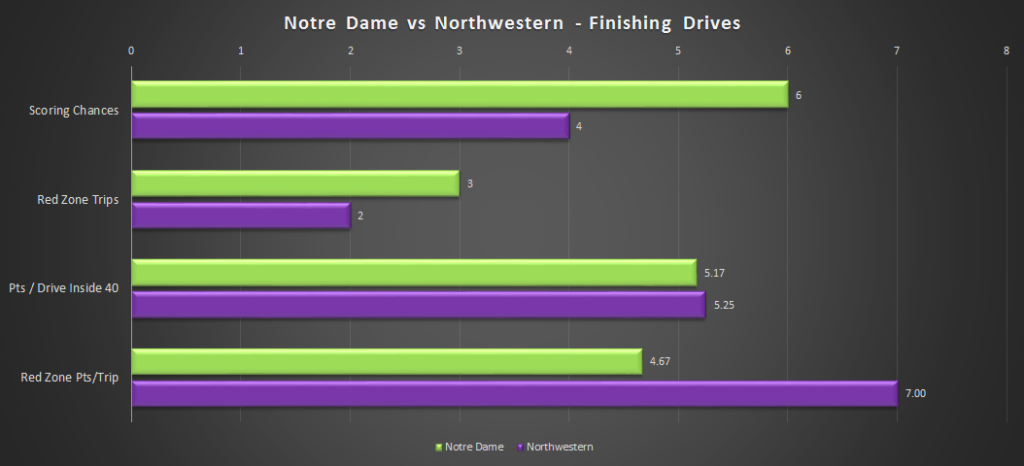
Both teams took advantage of their scoring opportunities, with the Irish generating a couple more of them. The one painful slip-up was the first half possession with first and goal from the Northwestern five where Notre Dame walked away with zero points after being backed up by penalties and a Yoon miss. The expected points from that scenario is around six points, so to come away empty-handed was an enormous missed opportunity. The defense was uncharacteristically giving on scoring chances for the Wildcats, but limited Pat Fitzgerald’s team to just four trips inside the Irish 40-yard line, so it didn’t hurt too much.
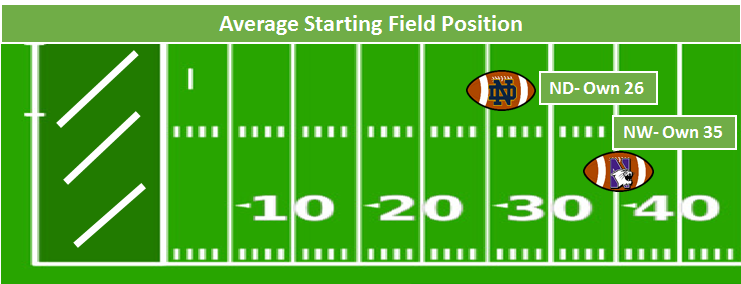
Field position is an area where the Wildcats made up significant ground – around 90 yards worth, factoring in the difference in average starting field position and a 10-11 possession game. The early fumble and late blocked punt gifted Northwestern two instant scoring opportunities, which the Irish were lucky only to give up a total of seven points off of. The gap in field position would be even wider excluding the end of game possession where Northwestern gave up the ball after failing to convert from their own 34 – the ND offense never received the ball in NW territory outside of that occasion.
The Irish lost the turnover battle 1-0 but continue to do things to create positive turnover differentials over the long-term. Notre Dame is now just +2 in turnover margin for the year, 53rd in FBS, but has an expected margin of +5.4 according to S&P+, good for 19th. This is a result of luck with pass deflections and fumbles recovered – in this game the Irish recovered zero of the two that hit the ground, and deflected five passes but didn’t register a pick. Ian Book had four passes deflected, which is not a huge number but higher than usual – his accuracy has just not given many chances for opposing defenses, except when he doesn’t see guys, which happened again a couple times against the Cats.
Returning to the big picture for just a moment, I think there is an opportunity defensively to see if the Irish can succeed generating a little bit more havoc through increased aggressiveness, even if only in preparation for the future. A “bend but don’t break” approach has been extremely successful for this unit, especially against inferior offensive lines and opponents that are unlikely to string together enough successful plays over the course of a game to score consistently. Rushing four and rarely bringing pressure has worked.
But the opposing offenses have been far from a murderer’s row (the best two opponents thus far are Michigan at 24th in Offensive S&P+ and Stanford at 30th), and I think there’s room for further improvement. The defense is just average in allowing 3rd down conversions (37.7%, 56th nationally), in part due to opponents having some of the shortest 3rd down average distances to go (6.8 yards, 107th in FBS). The defense is similarly average on opponent run stuffs and sack rates on passing downs, areas where you’d expect a team with this much talent in the front seven to shine.
Again, it’s hard to argue with the results, and I don’t believe the ND defense needs to be more aggressive to beat the offenses left on the schedule. FSU is a mess and Syracuse and USC are top 30-50 units, above average but nothing especially frightening. I do, however, agree with the idea I’ve seen from Mike Frank at ISD and others that increased aggression may be needed against a top opponent down the road. If this defense hasn’t had much game experience with that approach, there’s 1) likely to be assumptions versus proof on what the trade-offs are of a more aggressive approach and 2) less game experience leading to less optimal results.

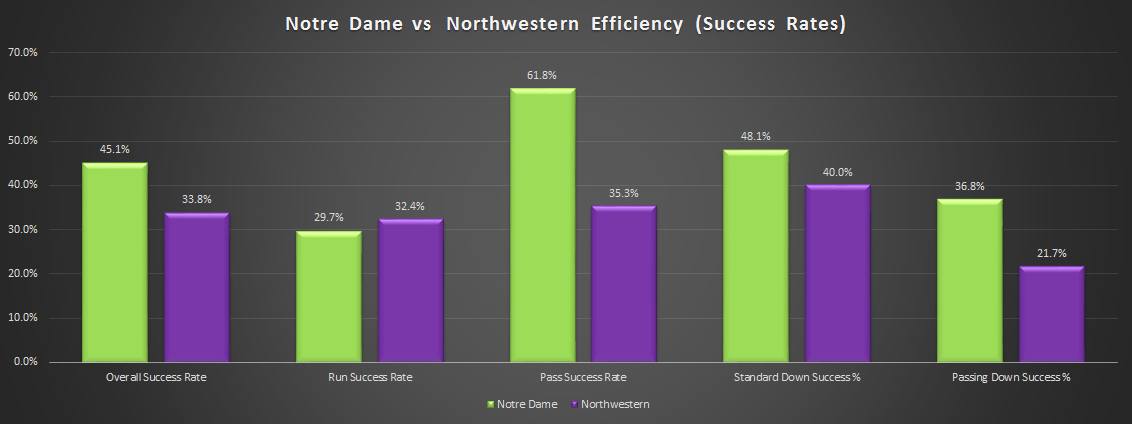



One other note I’ll drop here, as it relates to the playoff rankings / discussions and was of interest to our 18S Slack- Bill C. tweeted today that if you take only the Ian Book games, the Notre Dame S&P+ rating increases from 20.0 to 23.78.
The S&P+ rating itself is the expected margin versus an “average” FBS team, so this is saying we’re around 24 points better than an average team (Bama / Clemson, going just to the Trevor Lawrence era like we’ve done with Ian Book, are virtually tied at an insane +31.2. For context, last year only two teams finished over +20, Ohio State and Alabama.
That’s still ranked #6 no matter what, but does significantly close the gap to #5 UGA (23.84), #4 OU (25.0), and #3 Michigan (25.4). I think this is good evidence against the idea that you’ll see espoused some places that the Irish don’t really belong in the playoff (that in terms of actual quality, not record, we’re in a 3rd Tier behind Tier I (Bama + Clemson) and a Tier II of Michigan/UGA/Oklahoma in some order. There’s obviously still a big gap there between Bama/Clemson and everyone else, but I think we all know that…
“Against a playoff-caliber defensive line I’m extremely skeptical about Notre Dame’s ability to run the ball consistently, and hopeful that the coaching staff would be self-aware enough to recognize that and move more heavily to the pass game that’s been so effective with Book at the helm.”
@Traitor! You’re enabling low standards like those other Kelly apologists!@
Serious question: how much of what we’re seeing in the Book offense (Wake Forest on) is due to teams stacking the box following Pittsburgh? The run game seemed reasonably effective in Wake, Stanford, and VT. Then we had Pitt, Navy, and NW – and it only looked decent against Navy. However, I noticed NW using only one high safety most of the game and Pitt – after the first two drives – was putting 7-8 guys near the LOS.
What do the data say? Does NW have a better defense than Stanford, or did they just give us more in the passing game while focusing more on stopping the run?
Yes and yes. Northwestern is 23rd in S&P+ rush defense and Stanford is 63rd, so part of it is that they’re better at defending the run than Stanford. But I think Northwestern was definitely trying to follow the Pitt game plan to a degree, as that was the first defense that really slowed down Book – although they only slowed him down for a half, but hey, it’s better than nothing.
Northwestern also has pretty decent corners, so they could feel better about loading the box than many teams. I would imagine FSU will do something similar, especially now with BW playing. The key will be to keep them honest with outside runs and take the occasional PA deep shot.
A couple of things. It is hard for anyone to run on a playoff-caliber defensive line. That includes running against us. There is a reason they are playoff-caliber.
To beat a playoff-caliber team, you need balance. We now have that.
I don’t think we are third tier behind OU, UGA or Michigan. I think we are in that tier. I think Bama and Clemson are in Tier 1, then the rest of the contenders.
If we can get our explosiveness up, our numbers will go higher. Right now, we are too vulnerable to being strangled, much like LSU. Book is a better QB than Burrow, but he needs to improve his deeper balls to stretch the field and give him the shorter completions and the run game. He can throw them, but his accuracy is not there.
In the end ND’s best win (Mich.) far outweighs anything on Michigan’s schedule (tOSU). Even a Mich. fan would have to agree with that, no? I would say the rest of the schedules mostly balance out. If ND’s win over NW was not impressive enough, than Mich’s. was even less so. Win out and there’s no way they finish higher.
“Even a Mich. fan would have to agree with that, no?”
You (fortunately) must not have much experience with scUM fans and their warped logic!
Book is out for the FSU game?
…what?
http://www.espn.com/college-football/story/_/id/25214588/notre-dame-qb-ian-book-vs-florida-state
I feel sick.
Between this and Sessions’ resigning – ON EDGE TODAY
I won’t comment on the second part here, but I’m nodding my head.
Ian Book and Justice Ginsburg announced week to week with rib injuries on the same day. Coincidence?!?
And ND retroactively lost to NAVY
Better this week rather than the next two weeks, I guess?
Well this game is going to be a lot more “exciting” then.
So….this “undisclosed injury…” did he get caught violating parietals? Is something like that the injury?
From ISD:
The 6-foot, 203-pounder suffered multiple injuries to his midsection during this past week’s game at Northwestern, which will prevent him from playing in Saturday’s game.
A timetable for Book’s return is unknown at this point, although there’s some hope he’ll be ready for the Syracuse game on November 17th at Yankee Stadium.
We truly live in bizarro world when I can say “thank goodness he’s out for the FSU game, and he might be back against Syracuse!”
All my FSU friends are adamant that this won’t matter at all, that our D will strangle their offense and we need maybe 14-20 points to win.
I saw one FSU fan on twitter advise us to just run wishbone. They said it would be enough to cover.
Wimbush can’t make the reads – but seriously why not just run Wimbush like 25 times from the QB position and take some shots downfield.
Yep.
This will be fun.
This will be fun.
This will be fun.
This will be fun.
Calm down!
Rotate him with Jurk if we have to.
According to Pete Sampson, it was that hit Book took in the first quarter. The replay on his twitter feed shows the tackler’s knee hit him in the chest.
That makes sense. Maybe severely bruised or broken ribs? It’s hard to imagine even another week that Book wouldn’t be limited in some way from that injury even if he could play.
FSU will have been prepping for Book and his accuracy, so maybe they’ll forget BW can’t throw
I’m so excited for the QB draw on 3rd and 15! It might actually work!